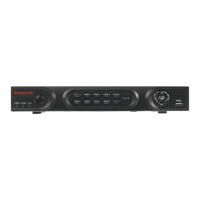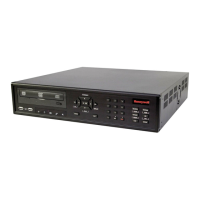
Do you have a question about the Honeywell HRGX81 and is the answer not in the manual?
Legal statements regarding device compliance and usage.
Guidelines for safe installation and operation of the DVR.
Lists other Honeywell documents relevant to operating the DVR.
Overview of the HRGX DVR's main capabilities and functionalities.
Detailed description of the buttons and indicators on the HRGX DVR's front panel.
Detailed description of the connectors and ports on the HRGX DVR's rear panel.
Instructions on how to use a mouse for controlling the HRGX DVR.
Guide to using the infrared remote control for the HRGX DVR.
Essential precautions to follow before and during the DVR installation process.
Instructions for connecting cameras, monitors, and other peripherals to the DVR.
Procedures for powering the DVR on and off correctly to ensure longevity.
Guidance on navigating the initial setup wizard for the HRGX DVR.
Steps to access the main user interface menu of the DVR.
How to configure the DVR's date and time for accurate event logging.
Instructions for updating the DVR's firmware locally or remotely.
Information on estimating hard drive space usage based on recording parameters.
Introduction to the DVR's live video monitoring mode.
How to customize screen layout and video output modes for live viewing.
Procedures for switching channels, outputs, and using digital zoom in live view.
Overview of controlling PTZ cameras connected to the DVR.
Steps to configure connection settings for PTZ cameras.
How to program and activate PTZ camera presets, patrols, and patterns.
Manually starting or stopping recording for specific channels or all channels.
Setting up schedules for automatic video recording based on time or events.
Configuring channels for manual recording, which overrides scheduled recording.
Setting up special recording configurations for holidays.
Defining stream types, resolutions, bitrates, and quality for video recording.
Setting up dual HDD recording for enhanced data security and reliability.
Locking video files or setting HDDs to read-only to prevent overwriting.
How to search and play back recorded video for a specific camera channel.
Retrieving and viewing recorded video based on specific dates and times.
Finding and playing back video recorded during alarm or motion detection events.
Locating and viewing video segments that have been tagged for easy retrieval.
Accessing video playback information through system log entries.
Performing actions like creating clips, adding tags, and managing playback.
Procedures for exporting recorded video files to external storage devices.
How to save custom video clips created during playback.
Setting up and configuring sensor inputs for alarm events.
Configuring how the DVR responds to alarm events via external outputs.
Setting up motion detection zones and sensitivity for video analytics.
Enabling and configuring settings to detect unauthorized tampering with camera lenses.
Configuring the DVR to detect and respond to video signal loss.
Setting up alarm responses for various system exceptions like HDD errors.
Configuring the DVR to send email notifications for alarms and exceptions.
Configuring the DVR to send notifications to a remote alarm monitoring center.
Basic network configuration for the DVR, including IP addressing and DHCP.
Advanced network configurations like PPPoE, DDNS, NTP, and SNMP.
Monitoring network traffic, bandwidth, and testing network connectivity.
Checking the operational status and health of installed hard disk drives.
Instructions for connecting and configuring NAS or SAN devices as network storage.
Managing multiple HDDs by grouping them for property and redundancy settings.
Limiting HDD capacity allocation for individual cameras.
Performing self-tests on HDDs to monitor their health and identify potential issues.
Scanning HDDs for bad sectors and methods for detection.
Setting up alarm responses for HDD full status or errors.
Customizing on-screen display text like date, time, and camera names.
Adjusting camera image parameters like brightness, contrast, and hue.
Defining areas on the camera view to be masked for privacy.
Setting up fundamental system parameters like language, resolution, and date/time.
Accessing details about the DVR's device, camera, record, alarm, network, and HDD status.
Methods for searching and exporting operational, alarm, and exception log data.
Saving DVR settings to a file and loading them back onto the device.
Instructions for updating the DVR's internal software.
Resetting the DVR's configuration to factory default values.
Explains the different user roles (Administrator, Operator, Guest) and their permissions.
Steps to create new user accounts for accessing the DVR.
Modifying existing user permissions and account details.
Removing user accounts from the DVR system.
Procedure for changing the primary administrator password for security.











